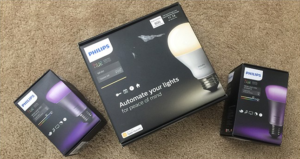Smart Lighting
Smart Lighting
There are many different smart lighting solutions in the market: Philips Hue, IKEA TRÅDFRI, Hive Active Light, Osram Lightify, Elgato Avea, Belkin WeMo Smart LED lighting, LIFX… Among all of them, there is one that works extremely well, high quality, very responsive, amazing apps… and a bit expensive. It’s Philips Hue and probably its best features are unexpected: Its ecosystem, community and API/SDKs, which I will use later in another post. In other words, it’s very easy to create new applications or develop ideas for Philips Hue by yourself if you know programming.
The only problem is that they are a bit expensive. Of course, you can try to get several components from the second-hand market (eBay, Gumtree, Facebook Marketplace…). I bought several light bulbs from Gumtree at 50% of their original price. Another trick is to use only white colour light bulbs rather than colour light bulbs in places you don’t really need colour.
Installing Philips Hue in your flat is very easy and no special knowledge is required. Note that in the corridor and the box room I use white light bulbs, this is just to cut costs because in those places, colour is not really needed. In my case, this is my configuration:
- Living room: 3 colour light bulbs, one Philips Hue Dimmer switch, Philips Hue router (Plus 2 extra Amazon Dash buttons, explained in another post).
- Bedroom: 3 colour light bulbs, one Philips Hue Dimmer switch (Plus one extra Amazon Dash buttons).
- Corridor/entrance: Philips Hue Motion Sensor and one white light bulb.
- Box room: Philips Hue Motion Sensor and one white light bulb.
- Kitchen and toilet: Because of some special sockets I have there, I cannot install Philips Hue there unless I remove those sockets, something I don’t want to do at the moment.
Controlling my living room with my voice:
Different ambients in my bedroom:

Advantages over non-smart lights (using my specific configuration):
- Completely automatic corridor/entrance and box room light. No need to use switches at all.
- Different ambients/scenes/moods using different colours and intensity, for example one for reading, another one for relaxing… using the Philips Hue iPhone app, you can create as many as you want. Using Philips Hue Dimmer switch you can iterate through 4 different scenes, and change the intensity as you want.
- Turn off all the lights automatically when you leave your flat, thanks to the iPhone app that tracks your location (geofencing). It can also turn on the lights when you arrive home, although personally I prefer to use motion sensors for that.
- Routines. For example, turn off the lights every night slowly (during 15 or 30 minutes).
- Attach spotify to your lights (suddenly your flat is the best nightclub).
- Annoy your guests when you are in the other room, changing colours, turning on/off the lights.
- Spy your guests when you are not in the flat (and optionally annoy them).
- Control your lights from another country or program routines for holidays to simulate that there are people inside the flat so thieves stay away.
- Synchronize the movies you watch with your lights, creating a more immersive experience.
- Total control using HomeKit and Siri. You can send commands with your voice like: “decrease intensity to 10% in the living room” or “change bedroom lights colour to red” (trust me, it can be useful).
Screen and lights synchronization and calibration using the app Ambient Light.
Sample movie using Ambient Light.
Two last recommendations:
- There are 2 official switches, Philips Hue Dimmer switch and Philips Hue Tap switch. The first one is very convenient and affordable. However, the second one is difficult to use and expensive. I don’t recommend it. In fact, I bought it and I sold it after a few weeks.
- There are also 2 routers, the old one (a circle), and the new one (a square with rounded corners). Don’t buy the old one, it’s outdated.


Recent Comments